Jinxing Zhou
CLASP: Cross-modal Salient Anchor-based Semantic Propagation for Weakly-supervised Dense Audio-Visual Event Localization
Aug 06, 2025Abstract:The Dense Audio-Visual Event Localization (DAVEL) task aims to temporally localize events in untrimmed videos that occur simultaneously in both the audio and visual modalities. This paper explores DAVEL under a new and more challenging weakly-supervised setting (W-DAVEL task), where only video-level event labels are provided and the temporal boundaries of each event are unknown. We address W-DAVEL by exploiting \textit{cross-modal salient anchors}, which are defined as reliable timestamps that are well predicted under weak supervision and exhibit highly consistent event semantics across audio and visual modalities. Specifically, we propose a \textit{Mutual Event Agreement Evaluation} module, which generates an agreement score by measuring the discrepancy between the predicted audio and visual event classes. Then, the agreement score is utilized in a \textit{Cross-modal Salient Anchor Identification} module, which identifies the audio and visual anchor features through global-video and local temporal window identification mechanisms. The anchor features after multimodal integration are fed into an \textit{Anchor-based Temporal Propagation} module to enhance event semantic encoding in the original temporal audio and visual features, facilitating better temporal localization under weak supervision. We establish benchmarks for W-DAVEL on both the UnAV-100 and ActivityNet1.3 datasets. Extensive experiments demonstrate that our method achieves state-of-the-art performance.
Autoregressive Image Generation with Linear Complexity: A Spatial-Aware Decay Perspective
Jul 02, 2025Abstract:Autoregressive (AR) models have garnered significant attention in image generation for their ability to effectively capture both local and global structures within visual data. However, prevalent AR models predominantly rely on the transformer architectures, which are beset by quadratic computational complexity concerning input sequence length and substantial memory overhead due to the necessity of maintaining key-value caches. Although linear attention mechanisms have successfully reduced this burden in language models, our initial experiments reveal that they significantly degrade image generation quality because of their inability to capture critical long-range dependencies in visual data. We propose Linear Attention with Spatial-Aware Decay (LASAD), a novel attention mechanism that explicitly preserves genuine 2D spatial relationships within the flattened image sequences by computing position-dependent decay factors based on true 2D spatial location rather than 1D sequence positions. Based on this mechanism, we present LASADGen, an autoregressive image generator that enables selective attention to relevant spatial contexts with linear complexity. Experiments on ImageNet show LASADGen achieves state-of-the-art image generation performance and computational efficiency, bridging the gap between linear attention's efficiency and spatial understanding needed for high-quality generation.
MOL-Mamba: Enhancing Molecular Representation with Structural & Electronic Insights
Dec 21, 2024



Abstract:Molecular representation learning plays a crucial role in various downstream tasks, such as molecular property prediction and drug design. To accurately represent molecules, Graph Neural Networks (GNNs) and Graph Transformers (GTs) have shown potential in the realm of self-supervised pretraining. However, existing approaches often overlook the relationship between molecular structure and electronic information, as well as the internal semantic reasoning within molecules. This omission of fundamental chemical knowledge in graph semantics leads to incomplete molecular representations, missing the integration of structural and electronic data. To address these issues, we introduce MOL-Mamba, a framework that enhances molecular representation by combining structural and electronic insights. MOL-Mamba consists of an Atom & Fragment Mamba-Graph (MG) for hierarchical structural reasoning and a Mamba-Transformer (MT) fuser for integrating molecular structure and electronic correlation learning. Additionally, we propose a Structural Distribution Collaborative Training and E-semantic Fusion Training framework to further enhance molecular representation learning. Extensive experiments demonstrate that MOL-Mamba outperforms state-of-the-art baselines across eleven chemical-biological molecular datasets. Code is available at https://github.com/xian-sh/MOL-Mamba.
Multimodal Class-aware Semantic Enhancement Network for Audio-Visual Video Parsing
Dec 17, 2024Abstract:The Audio-Visual Video Parsing task aims to recognize and temporally localize all events occurring in either the audio or visual stream, or both. Capturing accurate event semantics for each audio/visual segment is vital. Prior works directly utilize the extracted holistic audio and visual features for intra- and cross-modal temporal interactions. However, each segment may contain multiple events, resulting in semantically mixed holistic features that can lead to semantic interference during intra- or cross-modal interactions: the event semantics of one segment may incorporate semantics of unrelated events from other segments. To address this issue, our method begins with a Class-Aware Feature Decoupling (CAFD) module, which explicitly decouples the semantically mixed features into distinct class-wise features, including multiple event-specific features and a dedicated background feature. The decoupled class-wise features enable our model to selectively aggregate useful semantics for each segment from clearly matched classes contained in other segments, preventing semantic interference from irrelevant classes. Specifically, we further design a Fine-Grained Semantic Enhancement module for encoding intra- and cross-modal relations. It comprises a Segment-wise Event Co-occurrence Modeling (SECM) block and a Local-Global Semantic Fusion (LGSF) block. The SECM exploits inter-class dependencies of concurrent events within the same timestamp with the aid of a new event co-occurrence loss. The LGSF further enhances the event semantics of each segment by incorporating relevant semantics from more informative global video features. Extensive experiments validate the effectiveness of the proposed modules and loss functions, resulting in a new state-of-the-art parsing performance.
Dense Audio-Visual Event Localization under Cross-Modal Consistency and Multi-Temporal Granularity Collaboration
Dec 17, 2024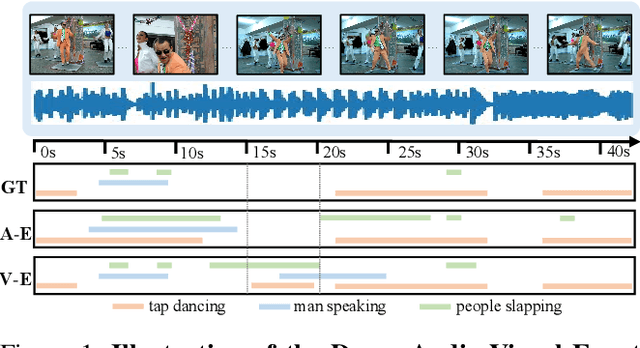
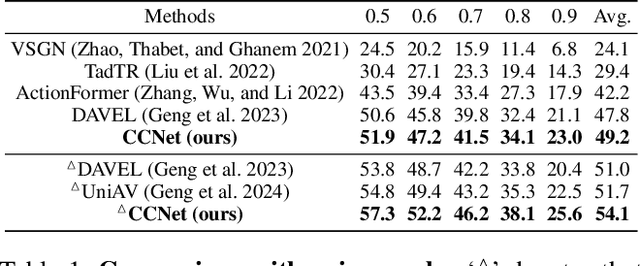
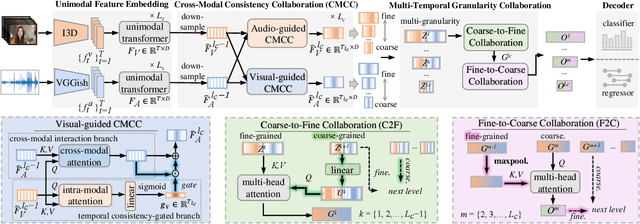
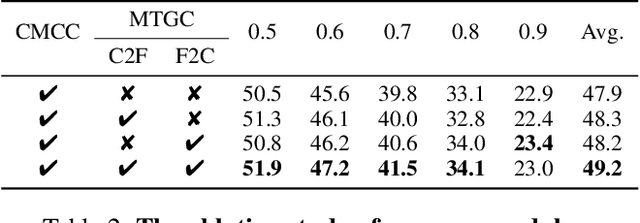
Abstract:In the field of audio-visual learning, most research tasks focus exclusively on short videos. This paper focuses on the more practical Dense Audio-Visual Event Localization (DAVEL) task, advancing audio-visual scene understanding for longer, {untrimmed} videos. This task seeks to identify and temporally pinpoint all events simultaneously occurring in both audio and visual streams. Typically, each video encompasses dense events of multiple classes, which may overlap on the timeline, each exhibiting varied durations. Given these challenges, effectively exploiting the audio-visual relations and the temporal features encoded at various granularities becomes crucial. To address these challenges, we introduce a novel \ul{CC}Net, comprising two core modules: the Cross-Modal Consistency \ul{C}ollaboration (CMCC) and the Multi-Temporal Granularity \ul{C}ollaboration (MTGC). Specifically, the CMCC module contains two branches: a cross-modal interaction branch and a temporal consistency-gated branch. The former branch facilitates the aggregation of consistent event semantics across modalities through the encoding of audio-visual relations, while the latter branch guides one modality's focus to pivotal event-relevant temporal areas as discerned in the other modality. The MTGC module includes a coarse-to-fine collaboration block and a fine-to-coarse collaboration block, providing bidirectional support among coarse- and fine-grained temporal features. Extensive experiments on the UnAV-100 dataset validate our module design, resulting in a new state-of-the-art performance in dense audio-visual event localization. The code is available at \url{https://github.com/zzhhfut/CCNet-AAAI2025}.
Patch-level Sounding Object Tracking for Audio-Visual Question Answering
Dec 14, 2024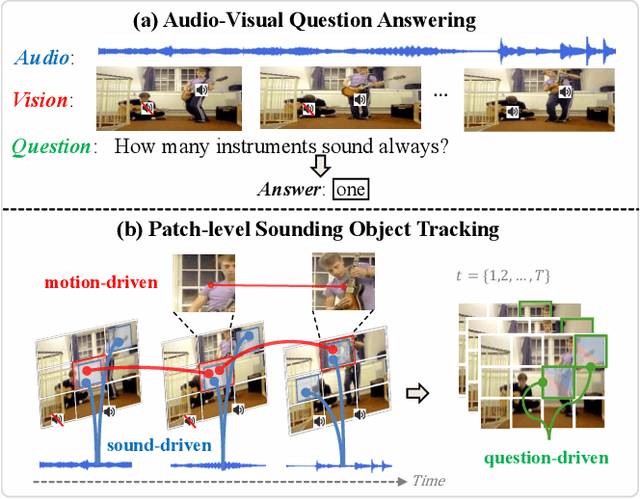

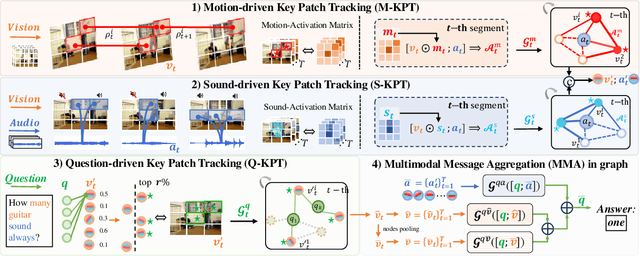

Abstract:Answering questions related to audio-visual scenes, i.e., the AVQA task, is becoming increasingly popular. A critical challenge is accurately identifying and tracking sounding objects related to the question along the timeline. In this paper, we present a new Patch-level Sounding Object Tracking (PSOT) method. It begins with a Motion-driven Key Patch Tracking (M-KPT) module, which relies on visual motion information to identify salient visual patches with significant movements that are more likely to relate to sounding objects and questions. We measure the patch-wise motion intensity map between neighboring video frames and utilize it to construct and guide a motion-driven graph network. Meanwhile, we design a Sound-driven KPT (S-KPT) module to explicitly track sounding patches. This module also involves a graph network, with the adjacency matrix regularized by the audio-visual correspondence map. The M-KPT and S-KPT modules are performed in parallel for each temporal segment, allowing balanced tracking of salient and sounding objects. Based on the tracked patches, we further propose a Question-driven KPT (Q-KPT) module to retain patches highly relevant to the question, ensuring the model focuses on the most informative clues. The audio-visual-question features are updated during the processing of these modules, which are then aggregated for final answer prediction. Extensive experiments on standard datasets demonstrate the effectiveness of our method, achieving competitive performance even compared to recent large-scale pretraining-based approaches.
Towards Open-Vocabulary Audio-Visual Event Localization
Nov 18, 2024Abstract:The Audio-Visual Event Localization (AVEL) task aims to temporally locate and classify video events that are both audible and visible. Most research in this field assumes a closed-set setting, which restricts these models' ability to handle test data containing event categories absent (unseen) during training. Recently, a few studies have explored AVEL in an open-set setting, enabling the recognition of unseen events as ``unknown'', but without providing category-specific semantics. In this paper, we advance the field by introducing the Open-Vocabulary Audio-Visual Event Localization (OV-AVEL) problem, which requires localizing audio-visual events and predicting explicit categories for both seen and unseen data at inference. To address this new task, we propose the OV-AVEBench dataset, comprising 24,800 videos across 67 real-life audio-visual scenes (seen:unseen = 46:21), each with manual segment-level annotation. We also establish three evaluation metrics for this task. Moreover, we investigate two baseline approaches, one training-free and one using a further fine-tuning paradigm. Specifically, we utilize the unified multimodal space from the pretrained ImageBind model to extract audio, visual, and textual (event classes) features. The training-free baseline then determines predictions by comparing the consistency of audio-text and visual-text feature similarities. The fine-tuning baseline incorporates lightweight temporal layers to encode temporal relations within the audio and visual modalities, using OV-AVEBench training data for model fine-tuning. We evaluate these baselines on the proposed OV-AVEBench dataset and discuss potential directions for future work in this new field.
Label-anticipated Event Disentanglement for Audio-Visual Video Parsing
Jul 11, 2024Abstract:Audio-Visual Video Parsing (AVVP) task aims to detect and temporally locate events within audio and visual modalities. Multiple events can overlap in the timeline, making identification challenging. While traditional methods usually focus on improving the early audio-visual encoders to embed more effective features, the decoding phase -- crucial for final event classification, often receives less attention. We aim to advance the decoding phase and improve its interpretability. Specifically, we introduce a new decoding paradigm, \underline{l}abel s\underline{e}m\underline{a}ntic-based \underline{p}rojection (LEAP), that employs labels texts of event categories, each bearing distinct and explicit semantics, for parsing potentially overlapping events.LEAP works by iteratively projecting encoded latent features of audio/visual segments onto semantically independent label embeddings. This process, enriched by modeling cross-modal (audio/visual-label) interactions, gradually disentangles event semantics within video segments to refine relevant label embeddings, guaranteeing a more discriminative and interpretable decoding process. To facilitate the LEAP paradigm, we propose a semantic-aware optimization strategy, which includes a novel audio-visual semantic similarity loss function. This function leverages the Intersection over Union of audio and visual events (EIoU) as a novel metric to calibrate audio-visual similarities at the feature level, accommodating the varied event densities across modalities. Extensive experiments demonstrate the superiority of our method, achieving new state-of-the-art performance for AVVP and also enhancing the relevant audio-visual event localization task.
Advancing Weakly-Supervised Audio-Visual Video Parsing via Segment-wise Pseudo Labeling
Jun 03, 2024Abstract:The Audio-Visual Video Parsing task aims to identify and temporally localize the events that occur in either or both the audio and visual streams of audible videos. It often performs in a weakly-supervised manner, where only video event labels are provided, \ie, the modalities and the timestamps of the labels are unknown. Due to the lack of densely annotated labels, recent work attempts to leverage pseudo labels to enrich the supervision. A commonly used strategy is to generate pseudo labels by categorizing the known video event labels for each modality. However, the labels are still confined to the video level, and the temporal boundaries of events remain unlabeled. In this paper, we propose a new pseudo label generation strategy that can explicitly assign labels to each video segment by utilizing prior knowledge learned from the open world. Specifically, we exploit the large-scale pretrained models, namely CLIP and CLAP, to estimate the events in each video segment and generate segment-level visual and audio pseudo labels, respectively. We then propose a new loss function to exploit these pseudo labels by taking into account their category-richness and segment-richness. A label denoising strategy is also adopted to further improve the visual pseudo labels by flipping them whenever abnormally large forward losses occur. We perform extensive experiments on the LLP dataset and demonstrate the effectiveness of each proposed design and we achieve state-of-the-art video parsing performance on all types of event parsing, \ie, audio event, visual event, and audio-visual event. We also examine the proposed pseudo label generation strategy on a relevant weakly-supervised audio-visual event localization task and the experimental results again verify the benefits and generalization of our method.
TAVGBench: Benchmarking Text to Audible-Video Generation
Apr 22, 2024Abstract:The Text to Audible-Video Generation (TAVG) task involves generating videos with accompanying audio based on text descriptions. Achieving this requires skillful alignment of both audio and video elements. To support research in this field, we have developed a comprehensive Text to Audible-Video Generation Benchmark (TAVGBench), which contains over 1.7 million clips with a total duration of 11.8 thousand hours. We propose an automatic annotation pipeline to ensure each audible video has detailed descriptions for both its audio and video contents. We also introduce the Audio-Visual Harmoni score (AVHScore) to provide a quantitative measure of the alignment between the generated audio and video modalities. Additionally, we present a baseline model for TAVG called TAVDiffusion, which uses a two-stream latent diffusion model to provide a fundamental starting point for further research in this area. We achieve the alignment of audio and video by employing cross-attention and contrastive learning. Through extensive experiments and evaluations on TAVGBench, we demonstrate the effectiveness of our proposed model under both conventional metrics and our proposed metrics.
 Add to Chrome
Add to Chrome Add to Firefox
Add to Firefox Add to Edge
Add to Edge